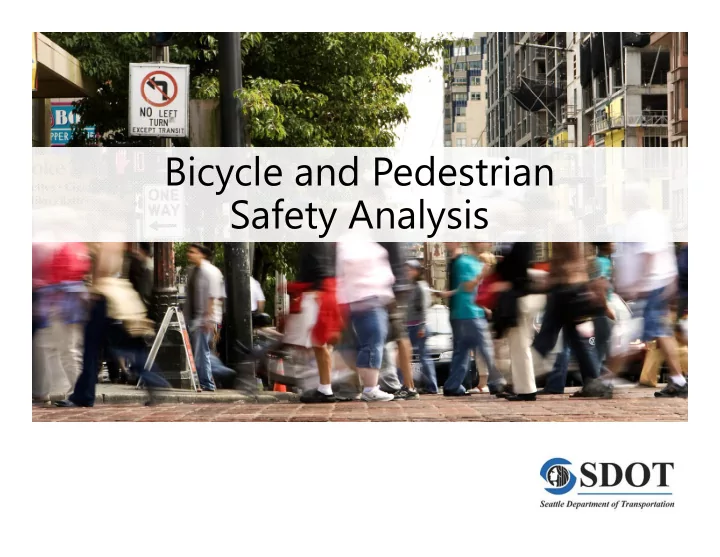

Bicycle and Pedestrian Safety Analysis
What is Vision Zero? • End traffic deaths and serious injuries by 2030 • Multi-faceted approach through data driven action and the many E’s of Safety: – Engineering – Education – Enforcement – Evaluation – Equity 2
Data Pedestrian and bicycle collisions make up 7% of total crashes but 47% of fatalities 9 out of 10 bike/ped collisions result in injury 3
Purpose of Bicycle and Pedestrian Safety Analysis • Better understand risk factors contributing to pedestrian and bicyclist crashes • Proactively and systemically address risk factors to mitigate potential crashes • Advance Seattle’s Vision Zero Goals
Data At a Glance – Crash Data
Bicycle Collision Trends
Pedestrian Collision Trends
Data Up Close – Roadway Data Lane Crashes Associated with Crash Data Data Lane Data Crashes Associated with Crash Crosswalk Data Data Crosswalks
Exploratory Analysis
Exploratory Analysis - Bicycle Collision Type % of T otal % of Severe/Fatal Left Hook 13.9 21.5 Angle 9.4 9.9 Right Hook 7.1 2.7 Dooring 5.0 6.0
Exploratory Analysis - Pedestrian Collision Type % of T otal % of Severe/Fatal Left hook at crossing 29.1 20.7 (controlled) Angle at crossing 23.0 31.0 (controlled) Angle at midblock 21.7 33.8 (uncontrolled)
Exploratory Analysis
Exploratory Analysis
Accounting for Exposure Exposure = level of pedestrian/bicycling activity Pedestrian Activity Bicycle Activity Annualized count data • Annualized count data • Trip generators • • Trip generators Strava data • Bicycle Network • Trip generators: housing units (single family or multifamily), commercial destinations, transit locations, and universities or schools.
Pedestrian Volumes
Bike Volumes
A Proactive, Systemic Approach Focusing on modeled collision rates at intersection locations based on the 5 following prioritized collision types: • T otal bicycle collisions • T otal pedestrian collisions • Opposite direction bicycle collisions • Angle bicycle collisions • Angle pedestrian collisions
Leading Edge Analysis Multivariate Analysis Identify Risk Factors Ranked Lists of Locations by Safety Performance Factor
A Proactive, Systemic Approach Data Analysis BOD_int Rank Rank Rank Rank Freq Pred Freq Pred PSI EB EB Est Significant Risk Factors INTKEY Location 27153 Eastlake Ave E & Fuhrman Ave E 9 6 8 1 1 1 12 Stone Way N & N 34 th St 26896 1 3 2 140 2 14 12280 27112 Eastlake Ave NE & University BR 0 2 1 3179 3 36 12283 29515 Denny Way & Dexter Ave 1 2 2 222 4 17 12278 27157 Eastlake Ave E &Harvard Ave E 0 2 1 3209 5 53 12282 28783 Dexter Ave N & Harrison St 3 2 2 17 6 9 63 Ranked list of locations 12 th Ave & E Cherry St 29795 0 2 1 5281 7 79 12281 12 th Ave & E Jefferson St 29809 3 2 2 19 8 10 61 where intervention may be 25 th Ave NE & NE Blakeley St 25949 5 2 3 3 9 3 8 29761 12 Ave & E Madison ST 6 2 4 2 10 2 1 needed 12 th Ave & E Columbia St 29791 0 2 1 5277 11 89 12279 269714 Cremona St & Nickerson ST 0 1 1 11860 12 113 12277 28736 Dexter Ave N & Valley ST 2 1 2 37 13 19 307 29812 Broadway & Jefferson St 0 1 1 5292 14 120 12276 28767 Dexter Ave N & Mercer St 5 1 3 5 15 4 6 28731 Aloha St & Dexter Ave N 1 1 1 186 16 50 11908 Field Investigations 12 th Ave & E Pine St 29740 0 1 1 5236 17 156 12275 3 rd Ave W & W Nickerson St 26688 2 1 2 23 18 21 269 28741 Dexter Ave N & Roy St 1 1 1 187 19 56 11808 Fremont Ave N & N 34 th ST 27039 4 1 3 7 20 7 10 Identify Safety Improvements
A Proactive, Systemic Approach
How is Seattle Going to Use Findings? • Identify locations where street or signal design changes may be needed • Make informed decisions around prioritizing safety improvements • Proactively treat locations with the intention of mitigating potential crashes
Key Takeaways • Consistent and accurate crash data is key to a data- driven approach • Simple statistical and spatial analysis can reveal informative patterns that may not be apparent • Understanding exposure is key to understanding risk, prioritizing safety improvements
Where do we go from here? • Incorporate more regression inputs • Validate countermeasure approaches • Further develop predictive volume models for the entire city • Rerun BPSA in future with better bicycle data after bicycle network is developed • Promote education and enforcement
Questions? Chris.Svolopoulos@seattle.gov http://www.seattle.gov/visionzero
Recommend
More recommend